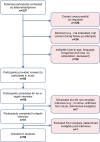Ethical and Psychosocial Factors in the Decision-Making and Informed Consent Process for Upper Extremity Vascularized Composite Allotransplantation: A Mixed-Methods Study
- PMID: 37492079
- PMCID: PMC10365204
- DOI: 10.1097/TXD.0000000000001515
Ethical and Psychosocial Factors in the Decision-Making and Informed Consent Process for Upper Extremity Vascularized Composite Allotransplantation: A Mixed-Methods Study
Abstract
Although upper extremity (UE) vascularized composite allotransplantation (VCA) aims to improve quality of life, relatively few have been performed worldwide to support evidence-based treatment and informed decision-making.
Methods: We qualitatively examined factors contributing to anticipated and actual decision-making about UE VCA and perceptions of the elements of informed consent among people with UE amputations, and UE VCA candidates, participants, and recipients through in-depth interviews. Thematic analysis was used to analyze qualitative data.
Results: Fifty individuals participated; most were male (78%) and had a mean age of 45 y and a unilateral amputation (84%). One-third (35%) were "a lot" or "completely" willing to pursue UE VCA. UE VCA decision-making themes included the utility of UE VCA, psychosocial impact of UE VCA and amputation on individuals' lives, altruism, and anticipated burden of UE VCA on lifestyle. Most respondents who underwent UE VCA evaluation (n = 8/10) perceived having no reasonable treatment alternatives. Generally, respondents (n = 50) recognized the potential for familial, societal, cultural, medical, and self-driven pressures to pursue UE VCA among individuals with amputations. Some (n = 9/50, 18%) reported personally feeling "a little," "somewhat," "a lot," or "completely" pressured to pursue UE VCA. Respondents recommended that individuals be informed about the option of UE VCA near the amputation date.
Conclusions: Our study identified psychosocial and other factors affecting decision-making about UE VCA, which should be addressed to enhance informed consent. Study participants' perceptions and preferences about UE VCA suggest re-examination of assumptions guiding the UE VCA clinical evaluation process.
Copyright © 2023 The Author(s). Transplantation Direct. Published by Wolters Kluwer Health, Inc.
Conflict of interest statement
All 8 UE VCA participants and recipients commenting about the disclosure process valued the information the transplant team disclosed. No one perceived the information as not important. Four commented that the transplant team was “very open,” “very detailed,” and respondents felt “very informed” about UE VCA. Information was most commonly provided in pamphlets, verbally, and by email. Respondents disliked paper packets due to difficulty “turning pages,” or found information “overwhelming.” Instead, they suggested providing information in a “digital form,” such as a website, and in “little sections” to prevent overwhelming patients.The authors declare no conflicts of interest.
Figures
Similar articles
-
A Patient-Centered Website (Within Reach) to Foster Informed Decision-making About Upper Extremity Vascularized Composite Allotransplantation: Development and Usability Study.JMIR Form Res. 2023 Feb 7;7:e44144. doi: 10.2196/44144. JMIR Form Res. 2023. PMID: 36749618 Free PMC article.
-
Information needs and development of a question prompt sheet for upper extremity vascularized composite allotransplantation: A mixed methods study.Front Psychol. 2022 Sep 5;13:960373. doi: 10.3389/fpsyg.2022.960373. eCollection 2022. Front Psychol. 2022. PMID: 36132190 Free PMC article.
-
Psychosocial predictors in upper-extremity vascularized composite allotransplantation: A qualitative study of multidimensional experiences including patients, healthcare professionals, and close relatives.Front Psychol. 2023 Feb 9;14:1092725. doi: 10.3389/fpsyg.2023.1092725. eCollection 2023. Front Psychol. 2023. PMID: 36844321 Free PMC article.
-
Psychosocial and bioethical challenges and developments for the future of vascularized composite allotransplantation: A scoping review and viewpoint of recent developments and clinical experiences in the field of vascularized composite allotransplantation.Front Psychol. 2022 Dec 15;13:1045144. doi: 10.3389/fpsyg.2022.1045144. eCollection 2022. Front Psychol. 2022. PMID: 36591015 Free PMC article.
-
A review of utilities and costs of treating upper extremity amputations with vascularized composite allotransplantation versus myoelectric prostheses in Canada.JPRAS Open. 2022 Mar 19;32:150-160. doi: 10.1016/j.jpra.2022.03.003. eCollection 2022 Jun. JPRAS Open. 2022. PMID: 35402680 Free PMC article. Review.
Cited by
-
The role of the purposeful shared decision making model in vascularized composite allotransplantation.Front Transplant. 2024 Jul 9;3:1421154. doi: 10.3389/frtra.2024.1421154. eCollection 2024. Front Transplant. 2024. PMID: 38993756 Free PMC article.
-
Patient definitions of transplant success in upper extremity vascularized composite allotransplantation: A mixed-methods study.SAGE Open Med. 2023 Jul 13;11:20503121231184677. doi: 10.1177/20503121231184677. eCollection 2023. SAGE Open Med. 2023. PMID: 37465724 Free PMC article.
References
-
- Ostlie K, Franklin RJ, Skjeldal OH, et al. . Assessing physical function in adult acquired major upper-limb amputees by combining the Disabilities of the Arm, Shoulder and Hand (DASH) Outcome Questionnaire and clinical examination. Arch Phys Med Rehabil. 2011;92:1636–1645. - PubMed
-
- Belon HP, Vigoda DF. Emotional adaptation to limb loss. Phys Med Rehabil Clin N Am. 2014;25:53–74. - PubMed
-
- Sheehan TP, Gondo GC. Impact of limb loss in the United States. Phys Med Rehabil Clin N Am. 2014;25:9–28. - PubMed
-
- Ziegler-Graham K, MacKenzie EJ, Ephraim PL, et al. . Estimating the prevalence of limb loss in the United States: 2005 to 2050. Arch Phys Med Rehabil. 2008;89:422–429. - PubMed
-
- Biddiss EA, Chau TT. Upper limb prosthesis use and abandonment: a survey of the last 25 years. Prosthet Orthot Int. 2007;31:236–257. - PubMed
LinkOut - more resources
Full Text Sources




